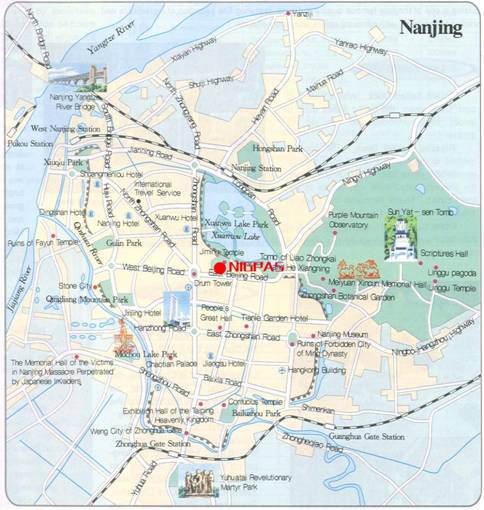
Map of Nanjing (ClickOn GoogleMapsTo Get MoreMap Details)
Nanjing, called Ning for short, is located in the Yangtze River Delta, facing fertile Jiangsu Southern areas on the east, hills of Anhui Province on the west, Tai Lake on the south and Jianghuai plain on the north. Since it is the intersection of Yangtze River—an east-west water transport artery and Nanjing-Beijing railway—a south-north land transport artery, hence the name “door of the east and west, throat of the south and north”.
Furthermore, the west part of the Ningzhen range is in Nanjing; the Loong-like Zhong Mountain is curling in the east of the city; the tiger-like Stone Mountain is crouching in the west of the city, hence the name “the Zhong Mountain, a dragon curling, and the Stone Mountain, a tiger crouching”. Mr. Sun Yet-sen spoke highly of Nanjing in the “Constructive Scheme for Our Country”, “The position of Nanjing is wonderful since mountains, lakes and plains all integrated in it. It is hardly to find another city like this.” With history of over 6,000 years, Nanjing has become a famous historical and cultural city since it was established 2,500 years ago. Since the 3rd Century AD, 10 dynasties and regimes made Nanjing the capital and established the country: Wu, Eastern Jin, Southern Dynasties (Sung, Qi, Liang, Chen), Southern Tang, Ming, Taiping Heavenly Kingdom and the Republic of China, hence the titles “Ancient Capital for Six Dynasties” and “Capital City for Ten Dynasties”. The history has left abundant Chinese historical and cultural relics in Nanjing.
The urban scenario of Nanjing is composed of historical and cultural relics, modern and civilized economics and grand and beautiful natural scenery.
Nanjing is a modern city with energetic economics. Pillar industries such as high-tech electronic information, auto industry, petrochemical industry and iron and steel industry have built a strong basis of Nanjng’s industry and formed a complete industrial system. Nanjing is an important modern manufacturing base. Besides, the advantage of developing modern service industry is obvious—five big regional service centers have been formed in the field of modern logistics, tourism exhibition, finance, information and trade.
Nanjing is also a city of excellent specialists for scientific education. As one of the four scientific research education cities in the country, Nanjing has 41 general higher universities (not including military schools) with over 600,000 students. The portion of students in every ten thousand people ranks the first in cities of China. Moreover, more than 540 various scientific research organizations in Nanjing with 530,000 research staffs.
Most strikingly, Nanjing has 79 academicians of the Chinese Academy of Sciences and Engineers.
Nanjing is a central city with wonderful regional advantages. As one of the ten big airports in China, the Nanjing Lukou International Airport has opened international passenger and freight transportation airlines from Nanjing to London, Frankfurt, Amsterdam, Vancouver, Los Angeles, Chicago, Moscow, Tokyo, Singapore and Seoul, etc. The total number of cities that are in the airlines of the Lukou airport reaches 65. Besides, the Nanjing harbor is the largest inland one in Asia with range of nearly 200 harbors in 80 countries.
Nanjing is an ecological city with comfortable human-habitat environment. Since implementation of the construction—“Green Nanjing” in 2003, Nanjing has fasten the speed of urban greening. The afforestation coverage in the city has reached 45.9%. No wonder the titles it has won: “City of National Park”, “National Sanitary City”, “Model City of National Environmental Protection”, “Model City of National Afforestation”. Nanjing has already become one of the modern cities which are the most comfortable for living.
Nanjing is a civilized city with open minds. At present, corporations from 104 countries and regions have made investments on 10,500 projects, 105 of which have been invested by 81 Top 500 corporations, such as BASF, Siemens, Shell, BP, Ericsson, Ford, Motorola, Sharp, Fujitsu, LG, Samsung, etc. They have also set up 17 branch companies and 19 representative institutions.
Nanjing is a safe city with good consciousness of laws and regulations. With good public security and sound prevention and control system, the rate of occurrence of crime cases is the lowest in the cities of its kind. The general satisfaction of citizens towards public security is 95%. In addition, the good traffic order won Nanjing the “First Prize of National City for Smooth Traffic” several times.
As the province capital of Jiangsu, Nanjing has 11 districts: Xuanwu, Gulou, Jianye, Qinhuai, Xiaguan, Yuhuatai, Qixia, Jiangning, Pukou and Liuhe as well as 2 counties: Lishui and Gaochun. The total coverage of municipal district is 6,598 square kilometers and the urban space is 4,730 square kilometers. The level of urbanization is above 75% with over 7.4 million permanent residents.
Nanjing belongs to the north subtropical monsoon climate zone with four seasons, plenty sunshine and rains. The average temperature of a year is 17.8℃ and the amount of precipitation of a year is 1034 mm.
